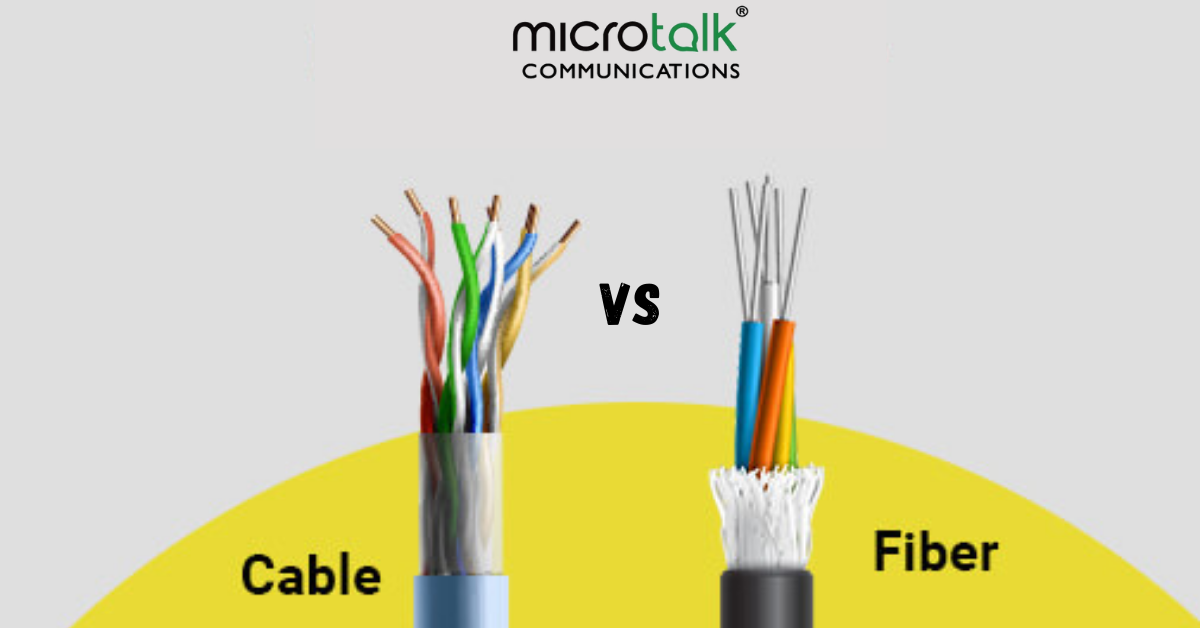
In a nutshell, Fiber-Optic Internet vs. Cable: Fiber is faster than copper, can go longer distances, is more secure, reliable, and durable than copper, is easier to scale, and is less expensive in the long run than copper.
While most company decision-makers are aware of fiber's speed advantages, other perks are less well-known. Spending money on newer technology might feel dangerous, especially for businesses that rely on Internet access for customer communications, productivity, and collaboration.
In this post, we'll look at how fibre optic Internet compares to traditional copper connection in terms of bandwidth potential, speed, and reliability, among other things.
Investing in fibre optic Internet can greatly expand your bandwidth capacity. TDM technology and copper wire infrastructure are constrained by nature. The demand for bandwidth was not large because it was originally meant for transmitting solely voice conversations. T-1, for example, has a throughput limit of 1.5 Mbps. Many forms of connections over cable are limited by distance due to the way electrical signalling operates.
If the circuit is longer than 15,000 feet, Ethernet over Copper (EoC) is usually not an option. Having your bandwidth provided over fibre can be an invaluable benefit for enterprises considering switching their phone services to Voice-over-IP (VoIP).
Is the difference in speed between fibre optic and cable Internet noticeable? Absolutely.
Many Atlantech Online clients who connect to our network by fibre can send data at speeds of up to 1 gigabit per second. That's a lot faster than the federal government's definition of broadband, which as of January 2019 was 25 Mbps uploads and 3 Mbps downloads.
Downloads that take 22 minutes over ordinary copper wire Internet connections can take as little as 8 seconds over fibre, according to the tech site NorthWest.
The concept of "waiting for items to load" is soon to become obsolete, thanks to technological advancements.
As the signal is carried from the central office, it degrades for copper Internet networks (CO). Long-haul networks were the first to use fibre. Fiber optic cable connects cell phone towers in faraway regions to the network.
Certain types of fibre connections, according to Blackbox Technology, can be transmitted for nearly 25 kilometres. While most business expansions will not necessitate such substantial fibre connections, your signal will not suffer degradation within the metro fibre rings that will serve your company.
Fiber optic is regarded as a cost-effective approach to rapidly boost your Internet security in an era when cybersecurity is receiving more attention.
Connecting taps to a line to pick up electrical signals can be used to intercept copper wire. Intercepting data transmissions via a fibre optic Internet cable, on the other hand, is extremely difficult.
Compromise cables, which generate visible light from transmissions, are also simple to spot. With the rise of distributed-denial-of-service (DDoS) assaults, it's more critical than ever to beef up your network's security.
When a company relies on copper cable-based Internet, there are a variety of variables that can create disruptions. Temperature changes, extreme weather, and wetness can all result in a loss of connectedness. Because it carries an electric current, old or worn copper cable can even be a fire hazard.
Cable also poses the potential of interference from electrical or radio signals, which adds to the reliability difficulties. Furthermore, telephone company staff have access to copper cables within the building, and they can make mistakes and tamper with the wrong connections. Furthermore, all copper wires return to the telephone company's central office, where disconnections might occur. Fiber is usually unaffected by the phone company, its equipment, or its termination points.
The weight of copper cable utilised has a direct relationship with the speed of Internet transmission. More cable is required to attain better speeds, which necessitates more space in a company's telecommunications room.
Fiber's speed is unrelated to its size, and it is significantly lighter than copper. This makes it easier to use and less demanding on small spaces' limited space.
In the short term, fibre Internet is more expensive than copper, but as this option becomes more prevalent, costs are rapidly reducing. In the end, the total cost of ownership (TCO) of fibre is lower during its lifespan. It's more durable, less expensive to maintain, and takes less resources.
Because of the benefits of fibre optic Internet, it is a more cost-effective investment for businesses of all sizes.
Follow us on:-
Linkedin- https://www.linkedin.com/company/microtalk-communications-pvt-ltd
Facebook - https://www.facebook.com/MicrotalkForU
Instagram - https://www.instagram.com/microtalk.communications
Youtube - https://www.youtube.com/channel/UC1xSsLkoNPtLimGwXVkQN1w
broadband providers in siliguri
microtalk broadband connection
Microtalk is the best broadband service provider in the eastern area of India
Thursday, December 9, 2021

